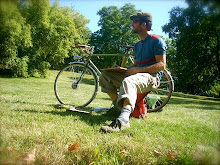
I have been under a bit of a deadline with the gallery that currently represents my work. As such, I have been trying to complete a small series of "Park" drawings. A number of which have recently been posted. This past saturday my plan was to load my gear and get out early, so as to have ample time to complete the 5th in a series of five drawings. Well, the prior evening, my plan took a rather swift and dramatic turn. Around 10:30pm, while working at the computer I noticed that in the shadows of the landing was a fluttering dark shape. I was focused on the matter at hand, but my instincts reacted, as I have seen and felt this before....not another moment passed and as I glanced over to take notice, I dropped to the floor as a bat was moving through my bedroom on a direct path towards me....well as direct as a bat ever seems to fly. I say that I have seen and felt this before, because it seems we have a bit of an annual bat colony in our "belfry". The first I encountered was in 2000. Our roof was being torn off and replaced. It was the early fall. In the late afternoon I was outside walking amidst the debris and I noticed a small creature in bad shape. He must have been startled awake during the tear off of that section and ended up badly injured, now three stories below and exposed to the world.
Since that time I have had to capture and remove over a dozen bats. Usually a couple each season loose their way on their departure run and end up trapped in the house. And as much as I admire and even love the little devil's, they just can't stay. The first one I mentioned surley died....he was just to beat up from the demo work that likely awoke him. Several years later one died while we were out east on our annual run to the ocean in Maine. It took a few days to track the faint smell of death down, but eventually I located his final resting spot. There have been a couple that have been dinged up by my cats..one of which is coincindentally named "batman".

Sadly, I had to kill one bat this past winter. Though I always go to great lengths to put them back in the wild alive and well. So, on this most recent occasion after much consternation, I decided to contain him in the sun porch and just sleep on it. They move much slower in the daylight and seem less so that they might actually be a vampire. In the morning, after coffee....I got the nerve up to capture my winged friend. When I found his resting place he was none to happy, and made a point of showing me all his teeth. I must admit that they seemed larger and more plentiful, than any creature his size should have. He was tucked into a blanket that was sandwiched between the wall and the day bed. I carefully cleared the room of stuff that I would likely trip over, should the capture go horribly wrong. And then went to gather my miscellaneous bat capture gear. I had an old mailing tube, so I decided to fashion a receptecle for the little fellow. You see, the reason I decided to sleep on it was because he was acting rather strange and aggressive the prior evening. We have had one survivor from a rabid bat bite in Wisconsin...I figure the odds of another survival follwing a similar incident are not so good. So it became evident at some point that he might need to be not only captured, but also be tested. And to get him tested he needed to be transported to the Humane Society, so I made the carrier pictured above. With a bit of care, a dose of patience and the aid of my nets, one attatched to a painter's extension pole, I eventually coaxed him into the tube, sealed him up and made sure he had air. To arrive at my drawing site, I knew that I would be heading In the direction of my local Humane Society. And so, this particular bat is the rare creature to have gone for a ride on a bicycle. I eventually managed to complete that fifth drawing on site in the V.A. Grounds.
a view of my grass floor studio from above
a bicyclejazz short animation. Also posted on YouTube for slightly better viewing quality
V.A. Grounds 4

V.A. Grounds 4: detail


















































